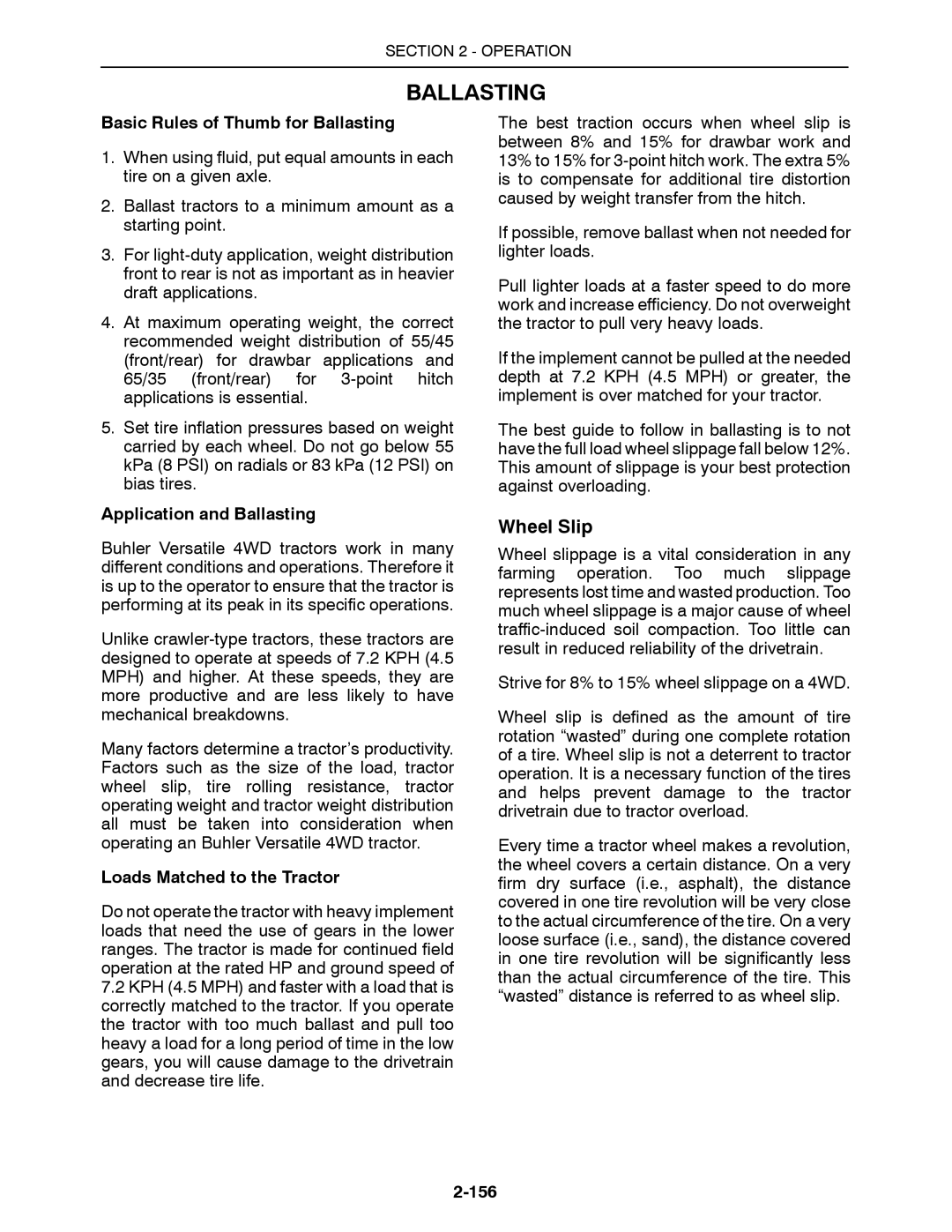SECTION 2 - OPERATION
BALLASTING
Basic Rules of Thumb for Ballasting
1.When using fluid, put equal amounts in each tire on a given axle.
2.Ballast tractors to a minimum amount as a starting point.
3.For
4.At maximum operating weight, the correct recommended weight distribution of 55/45 (front/rear) for drawbar applications and 65/35 (front/rear) for
5.Set tire inflation pressures based on weight carried by each wheel. Do not go below 55 kPa (8 PSI) on radials or 83 kPa (12 PSI) on bias tires.
Application and Ballasting
Buhler Versatile 4WD tractors work in many different conditions and operations. Therefore it is up to the operator to ensure that the tractor is performing at its peak in its specific operations.
Unlike
Many factors determine a tractor’s productivity. Factors such as the size of the load, tractor wheel slip, tire rolling resistance, tractor operating weight and tractor weight distribution all must be taken into consideration when operating an Buhler Versatile 4WD tractor.
Loads Matched to the Tractor
Do not operate the tractor with heavy implement loads that need the use of gears in the lower ranges. The tractor is made for continued field operation at the rated HP and ground speed of
7.2KPH (4.5 MPH) and faster with a load that is correctly matched to the tractor. If you operate the tractor with too much ballast and pull too heavy a load for a long period of time in the low gears, you will cause damage to the drivetrain and decrease tire life.
The best traction occurs when wheel slip is between 8% and 15% for drawbar work and 13% to 15% for
If possible, remove ballast when not needed for lighter loads.
Pull lighter loads at a faster speed to do more work and increase efficiency. Do not overweight the tractor to pull very heavy loads.
If the implement cannot be pulled at the needed depth at 7.2 KPH (4.5 MPH) or greater, the implement is over matched for your tractor.
The best guide to follow in ballasting is to not have the full load wheel slippage fall below 12%. This amount of slippage is your best protection against overloading.
Wheel Slip
Wheel slippage is a vital consideration in any farming operation. Too much slippage represents lost time and wasted production. Too much wheel slippage is a major cause of wheel
Strive for 8% to 15% wheel slippage on a 4WD.
Wheel slip is defined as the amount of tire rotation “wasted” during one complete rotation of a tire. Wheel slip is not a deterrent to tractor operation. It is a necessary function of the tires and helps prevent damage to the tractor drivetrain due to tractor overload.
Every time a tractor wheel makes a revolution, the wheel covers a certain distance. On a very firm dry surface (i.e., asphalt), the distance covered in one tire revolution will be very close to the actual circumference of the tire. On a very loose surface (i.e., sand), the distance covered in one tire revolution will be significantly less than the actual circumference of the tire. This “wasted” distance is referred to as wheel slip.
